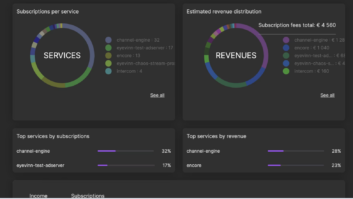While the market for digital video entertainment has never been more vibrant, the factors that created opportunities have also seeded the challenges faced by the sector today, according to Serhad Doken, chief technology officer for Adeia.
“The high consumer penetration of digital devices has combined with relatively low barriers for distributing video content to create a saturated market. As a result, a zero-sum race for subscribers’ attention and wallet share has emerged in which the path to growth for most service providers lies in taking market share from other players,” he explains.
In this context, over-the-top (OTT) streaming providers are exploring ways to create more engaging and interactive experiences with video entertainment content offerings. Engagement, he observes, is increasingly seen as a way to protect their market position by reducing churn while creating new revenue-generating opportunities.
“Sophisticated engagement strategies have become especially important as the economic environment remains in an uncertain state. We have seen significant differences in user behaviour emerge over the course of 2023 as consumers worry about their financial situation. It affects the streaming media sector as people look at their budgets and churn in and out of service provider subscriptions to save money,” says Doken.
Many OTT service providers are rolling out interactive features that offer subscribers more control over their experiences.
“For streaming services that depend on advertising revenues, this might include questions like: ‘Which ad would you like to watch? or ‘Did you enjoy this?’ The answers to these questions provide the basis for serving up content — including advertisements — aligned with the subscriber’s interests,” Doken says.
Some operators, he adds, are taking the concept a step or two further through “group watch” features that recreate the feeling of gathering in living rooms to watch content with friends and family.
“Meanwhile, others are reverting to more traditional programming strategies by investing in new content — including episodic television and live streams — that is doled out on specific nights of the week to create ‘time-and-place’ communities,” he says.
It harkens back to “must-see-TV” Thursdays when Seinfeld ruled the airwaves in broadcasting during the ’90s and the debut of premium pay-TV episodes — like Game of Thrones a decade ago.
Across these programming strategies, service providers are using a wide array of technologies to enable engagement — including video chat, text chat and even emojis — which not only serve to better engage viewers, but also generate a tremendous amount of data about inter-relationships across individual subscribers, content and service features.
“They also capture valuable insights into the social group relationships digital viewing communities create. Success in these scenarios requires thoroughly understanding end-user preferences and desired engagement methods,” Doken says.
Harnessing technology to get a competitive edge
In addition to developing skills and capabilities that blend e-commerce and content, companies should also focus on one more factor: gamification.
“Gamification is one of the reasons Twitch — a service that focuses on live-streaming video games, including broadcasts of esports competitions — has been so successful. People enjoy watching other people play games. It is a proven strategy for securing engagement and creating a sense of community through interactivity.
Another area of technology that providers must focus on is connectivity. Interactive engagement requires access to high-speed, low-latency connections that reduce lags or disruptions that detract from the user experience across a community.
“Connectivity — at wide-area networking and local-area networking levels — is also emerging as an essential factor for streaming live events, including sports and entertainment. Broadband innovation will contribute to drastic improvements in how consumers enjoy these experiences,” says Doken.
Service providers that master the development, deployment and management of effective technology-enabled engagement strategies will be best positioned to grow through the turbulent business landscape by opening new lines of dialogue with end users while creating higher levels of interactivity, intimacy and a sense of digital community.







